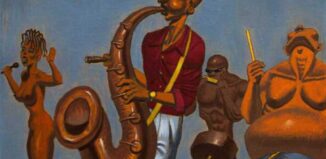The UMAMI Museum Field Trip
by Cecilia Kennedy
A swarm of children from the St. Lawrence Catholic Elementary School—all dressed in blue and white plaid uniforms—descended upon the University Museum of Art, Muses, and Inspiration (UMAMI) in the center of town one afternoon. They were on their best behavior, having previously been banned from field trips. (Henry and Justin, as the story went, had startled the monkeys at the zoo by throwing “snap-its” fireworks into their cages. The teachers and parents in charge of the trip thought that someone was shooting a gun in the area, so they made the children run for cover. However, security cameras in the vicinity caught the two St. Lawrence boys throwing the fireworks. Shortly thereafter, the second-grade class was banned from the zoo for life, and the school administration decided that the children shouldn’t be treated to anymore “experiential learning opportunities.” However, the school administrators also realized that they couldn’t keep them from cultural experiences. It just didn’t seem right. A zoo was one thing; art was another.)
At the same time that the children entered the museum, the Senior Citizens’ Home was treating residents to a trip to this very same museum. The occupants of that bus filed out in orderly fashion, and promptly expressed their disappointment that they’d have to share their outing with a group of school children who, at the moment, were not misbehaving, but who could turn on them at any moment. They just knew it.
The featured exhibit at the museum was called “More than ‘Eats’ the Eye”—a clever nod to a particularly talented food photographer/artist who happened to be presenting a lecture on his work. He was especially eager to speak to impressionable children. How precious! How delightful! He would certainly rock their world.
Meanwhile, the principal of St. Lawrence Catholic School, who was called in as extra back up if things turned ugly, directed her gaze upon the children. Many were smart, but many of them came from what she considered “broken homes.” No wonder they acted out, the poor dears. And, the ones who didn’t have strong reading scores, could probably excel at something. Some were showing great promise in art. They could grow up to be artists, perhaps . . .
The children began to form a circle in the central gallery. The artist—Reginald Piper—stood off center at a distance to gauge their reactions. They stared blankly up at the walls of photographs, which included a shiny stream of milk pouring out onto cereal flakes in a bowl, colorful ice cream scoops perfectly stacked upon one another inside a waffle cone, shiny red apples in a basket, enchiladas dripping with cheese and sauce, and fluffy pancakes covered in syrup.
They’d seen these things before. They’d probably eaten them too. What made this art? Reginald could read their presumptuous little minds, but he couldn’t stifle his laughter, which spilled out into the gallery and made the children turn around.
There, in a dark corner near the exit, they saw a strange, thin man dressed in a rather garish Kelly-green suit that was paired with a pastel pink and yellow checkered tie. He wore exceedingly round spectacles, which made his face seem small. Certainly, there was much that the children could make fun of. However, there was also something about him that they didn’t quite trust. Perhaps he knew their weaknesses and could gut them with humiliation.
“Yes, yes. Gather ‘round,” Reginald said, as he moved closer to the center of the circle. The senior citizens edged in closer too. They knew the presentation was for the children, but who would kick them out? Who would dare tell them to leave?
“I suppose this exhibit bores you,” Reginald began.
Truthfully, the children were bored. The zoo was better.
“I suppose you think you could take pictures of food that are just as good—” Reginald continued.
“I could take a better picture of Mrs. Motley’s face,” one of the children said. The others erupted in laughter. The senior citizens frowned.
“That’s enough!” Mrs. Motley, the principal said. She knew she wasn’t what the children would consider “pretty,” but she believed she was the most successful adult in the room. She had a job. A good job. Still, it hurt.
Reginald—not one to lose control of a class—stood right next to the boy who made the comment about Mrs. Motley’s face. All Reginald did was stand there quietly. The boy grew silent—not out of respect—but because he thought Reginald, standing so close to him, was creepy.
“Good. That’s good,” Reginald said, smiling. “Now that everyone’s paying attention, I can tell you that there’s more than ‘eats’ the eye in these photos.
Pointing to the photograph of the cereal in the bowl, Reginald said,
“I didn’t just snap a picture of a bowl of cereal. This photograph took nearly four hours to shoot correctly. Children, do you know what happens when flakes of cereal just sit in a bowl of milk?”
“They get wet and limp like Mr. Zenkins’ p—”
“Stop it!” Mrs. Motley shouted to the boy who made the comment. “I will send you home on the city bus now! You’ll be the only child on it, and I won’t care what happens to you!”
Reginald just raised his pointer finger and smiled. The children turned their attention back to him.
“Let me ask you a question—a simple one. How many of you have a bottle of glue in your desk at school?”
All of the children raised their hands.
“Well, glue looks a lot like milk. And, if you use enough of it and let it harden, it won’t ruin cereal flakes. Lots of things I use in these photos can’t be eaten—or maybe you could eat them, but you wouldn’t want to.”
During the rest of the presentation, the children learned how the ice cream scoops were really mounds of mashed potatoes, dyed in different colors. The maple syrup was actually motor oil, simply because it was thicker and more luxurious looking. The shiny red apples in the basket had been lovingly doused with hairspray.
“And now, we come to the enchiladas. Don’t they look delicious? Who likes enchiladas?”
A few of the children raised their hands.
“Well, many of us food photographers know, that in order to make the enchiladas look like they are stuffed with incredibly tasty ingredients, we could use mashed potatoes for the filling. But I found something better, children. Much, much better.”
Now, the children were paying attention. This was what their deranged little minds craved. By the time Reginald finished his story about how he found his enchilada stuffing in the alley, behind this very museum—on a body covered with boils that, when squeezed, looked like ground beef—Mrs. Motley was convinced that the children could definitely make something of themselves someday.
After the presentation, the children filed past the museum’s cafeteria, which displayed perfectly formed sushi rolls in the window. Little Rosie thought that the cubed pieces of tuna looked like the tip of her grandmother’s tongue, which she stuck out slightly when she would thread a sewing needle. And, for the first time, Rosie thought that maybe she had what it took to be an artist. Oh, if she could just get a hold of that tongue! Just the tip—sticking out from a roll of sushi—would make for a lovely photo.
BIO

Cecilia Kennedy earned a PhD in Spanish from The Ohio State University, and she taught Spanish and English Composition in Ohio for 20 years before moving to the state of Washington with her family. Twenty-three of her short stories have appeared in 17 literary magazines. She also writes a blog called Fixin’ Leaks and Leeks, where she details her humorous attempts at cooking and home repair: https://fixinleaksnleeksdiy.blog/


















